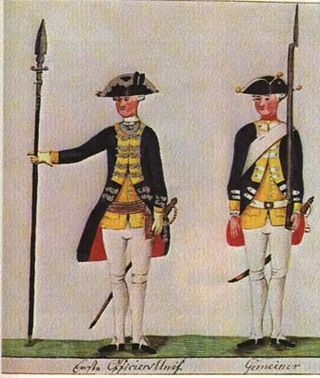黑森佣兵
来自维基百科,自由的百科全书
黑森佣兵(英语:Hessian、Hessian soldiers;德语:Soldatenhandel unter Landgraf Friedrich II. von Hessen-Kassel),即黑森士兵,又译赫斯佣兵,18世纪受大英帝国雇用的德意志籍佣兵组织。美国独立战争期间大约有30,000人在北美十三州服役,其中近半数来自德意志的黑森地区,其他来自类似的小邦。在英国服役的背景下,他们全部被归类为“黑森人”(Hessians),北美殖民地居民则称他们为“雇佣兵”。

黑森佣兵是以小队为单位受雇,非单人个别受雇。他们会得到报酬,但他们家乡各邦的贵族会收到大部分的资金,英国人发现与自行征募士兵相比,如此反而易于借款支付雇佣酬劳。[1]
英国在包括爱尔兰的数次战斗中运用了黑森佣兵,但最大规模地投入在美国独立战争中的军事行动,他们提供了大量人力以支持亲英派份子,独立派方面则利用这些士兵非英国籍的事实做政治宣传,并将他们描述为贪图金钱的受雇者,独立派也提供奖赏土地引诱他们背叛而加入美方。有多支德裔部队被派驻防于不列颠群岛顶替正规军务,以腾出更多英国正规军调赴北美洲服役。[2]
历史
1706年、1707年间,约有一支10,000人组成的黑森佣兵队于在欧根亲王的意大利军团中服役,直到1708年前往西属尼德兰为止。1714年,有6,000名黑森佣兵受瑞典雇用前往加入瑞典对俄罗斯的战争,随后的1715年有12,000人受雇于乔治一世以镇压詹姆斯党叛乱(Jacobite Rebellion)。1744年的奥地利王位继承战争中,有6000名黑森佣兵在法兰德斯对英国陆军作战,同时有另外6,000人在巴伐利亚陆军之中。1762年之前,有24,000名黑森佣兵在斐迪南公爵的普鲁士陆军中服役。[3]
在美国独立战争期间,黑森-卡塞尔伯爵腓特烈二世与其他德意志地区的领主出租了一部分常备陆军部队给大不列颠王国以对抗美国革命中的革命党,前后大约有30,000名士兵被交易到美洲服役。他们被称为黑森人(Hessians),因最大族群即人数总和的30,067人当中有12,992人来自黑森-卡塞尔地区。他们以完整的部队编制赴任,使用自己原有的制服、武器、军官。
兵源分别来自于黑森-哈瑙的威廉伯爵(Count William of Hesse-Hanau)、布伦瑞克-沃尔芬比特尔公爵查理一世、瓦尔德克亲王腓特烈·卡尔·奥古斯特、勃兰登堡安斯巴赫-拜律特边侯卡尔·亚历山大、安哈尔特-策尔布斯特亲王腓特烈·奥古斯特。

黑森佣兵不单独行动,贵族领主会决定是否将整支部队出租。许多人是被强制征召(Impressment)进入黑森部队服役的,逃兵会被迅速处死刑或被连队处夹道鞭笞(Gauntlet)。[4]在美国独立革命中,黑森佣兵大约占英国派遣军人数的四分之一;包括有猎兵、骠骑兵,三个炮兵连队和四个营的掷弹兵。大部分的步兵是称作“猎人”的狙击兵以及鸟枪兵、燧发枪兵(fusilier)。他们的武装是滑膛枪,炮兵使用3磅加农炮。最初每团平均由500至600人组成,后来在战争中每团只有300至400人。
1776年,黑森佣兵先遣部队约18,000人抵达北美,后续有更多部队到达。1776年8月15日,他们在纽约州史泰登岛登陆,随后于长岛会战首次参战,随后投入纽约及新泽西战役,10月在白原战役担当前锋,11月在华盛顿堡攻城战作为攻城主力取得胜利。12月26日翠登战役英军战败,黑森佣兵遭受惨重损失,1777年1月的阿孙平克溪战役及普林斯顿战役再度挫败。
1777年之后英国主要运用黑森佣兵为驻屯地的卫戍部队,黑森佣兵仍参与了几乎每场战斗,夏季的萨拉托加战役因英军投降而连带被俘数千人。1778年至1780年间,一支混编佣兵在南方各州的战役中战斗,包括吉尔福德县府战役,1781年则仍有两个团在约克镇围城战役中战斗。
英国对黑森部队的运用激怒了美国人的情绪,并促使更多的亲英派人士转向支持革命。他们将英国利用非英语系外国军队镇压叛乱的动作视为侮辱,因英国政府对待英籍军民与非英籍军民未有差别待遇。亲英派认为,英国殖民地居民应该有权不沦为雇佣兵的敌人。

在翠登战役,1776年12月26日早晨,乔治·华盛顿的大陆军渡过德拉瓦河突袭并击溃1,400人的黑森佣兵,有大约20名黑森兵被杀、约100人负伤以及1,000人被捕为战俘。[5]
一位在翠登战役被俘的黑森佣兵约翰·尼可拉斯·巴纳(Johann Nicholas Bahner)的家传记载,部分黑森士兵被告知他们的任务需求是抵御印地安人入侵北美十三州,当他们抵达北美洲才发现是受雇来对英国殖民地居民作战,而非印地安人。[6]在翠登战役被俘的黑森士兵于费城街头遭到游街示众,以激发在场美洲人的士气与怒气,有助于大陆军征募新兵。[7]大部分战俘被发配作为农场工人劳动。[8]
在1778年年初之前,华盛顿与英国之间展开了战俘交换的谈判。在一项一比一交涉中订定,若有一名黑森士兵叛逃,则也会少一名安全回家的美洲人。[9]尼可拉斯·巴纳(Nicholas Bahner)、雅各·斯特罗布(Jacob Strobe)、乔治·盖斯勒(George Geisler)、康拉德·克雷姆(Conrad Kramm)是少数被美方俘虏、在交涉中被归还后再自英军叛逃的黑森士兵,[10]他们因叛逃而被英军搜捕,也被许多殖民地居民通缉。
殖民地民兵方面持续试图诱使黑森佣兵自英方叛逃并加入德裔美籍人口。第二届大陆议会批准提供50英亩(近20公顷)的土地给个别的黑森士兵以鼓励其叛逃,同时也视军衔高低分别提供50至800英亩给英军逃兵。[11]
1777年8月,一篇匿名的法文讽刺信函“黑森佣兵的销售”(英语:The Sale of the Hessians)被广泛散布。这篇文章声称一位黑森佣兵指挥官希望更多麾下士兵死亡,如此他便可获得更优厚的补偿。该信函作者多年不明,直到1874年约翰·毕格罗(John Bigelow)将其翻译成英文,并主张作者是本杰明·富兰克林,以之收录当年出版的富兰克林自传《本杰明·富兰克林的一生》(The Life of Benjamin Franklin),但这个说法似乎欠缺证据支持。[12]

1777年夏季萨拉托加战役期间,英国将军约翰·伯戈因按照萨拉托加公约(Convention of Saratoga)的协议,以5,800兵力向美军将军何瑞修·盖茨(Horatio Gates)投降,美军将这支伯戈因的残余军队俘虏,称为“公约军”(Convention Army)。“公约军”的组成有很高比例是属于莱迪索将军(Friedrich Adolf Riedesel)麾下、来自布伦瑞克-吕讷堡的黑森士兵。美方将这些战俘解送至维吉尼亚州夏律第镇,监禁在阿尔伯马尔战俘营(Albemarle Barracks)直到1781年。之后再移送宾夕法尼亚州的雷丁及兰开斯特,直到1783年战争正式结束后,在北美服役的29,839名黑森佣兵当中有17,313人返回德意志故乡。在未返回的12,526人当中,有大约7,700人已死亡,其中大约1,200人在作战行动中被杀、大约6,354人死于多发于战争前期的疾病或意外事故。[13]又另有接近5,000名黑森佣兵从此定居于北美洲,美国与加拿大。
1795年10月的美因茨战役,克罗地亚贵族约翰·卡克雷维(Johann Keglevich)雇用黑森佣兵协助奥地利军击败法国。战后,英国于1798年紧急派遣黑森佣兵前往爱尔兰支援镇压受爱尔兰人团结协会(Society of United Irishmen)鼓动的叛乱;该组织原以议会改革为宗旨,后受美国革命与法国大革命影响,其成员于1798年前即开始寻求爱尔兰独立。
1798年4月11日,男爵霍姆佩斯第二步枪兵营(Baron Hompesch's 2nd Battalion of riflemen)自怀特岛登船开赴科克港,随后与第五猎兵营第六十团(Jäger 5th Battalion 60th regiment)会合。黑森佣兵活跃于6月的福克斯米尔战役(Battle of Foulksmills)与维尼格山战役(Battle of Vinegar Hill),并因残酷暴虐对待韦克斯福德居民而在爱尔兰恶名昭彰。
美国独立战争中的黑森佣兵单位
安哈尔特-策尔布斯特(Anhalt-Zerbst)
- 安哈尔特劳申布莱特公主团(Rauschenplatt's Princess of Anhalt's Regiment)
- 努佩瑙猎兵连(Nuppenau's Jäger Company)
- 安哈尔特-策尔布斯特炮兵连(Anhalt-Zerbst Company of Artillery)
安斯巴赫-拜律特(Ansbach-Bayreuth)
- 第一安斯巴赫-拜律特团(1st Regiment Ansbach-Bayreuth),后改名第一安斯巴赫营冯福特团(Regiment von Volt; 1st Ansbach Battalion)
- 第二安斯巴赫-拜律特团(2nd Regiment Ansbach-Bayreuth),后改名第二拜律特营塞伯亨团(Regiment Seybothen; 2nd Bayreuth Battalion)
- 安斯巴赫猎兵连(Ansbach Jäger Company)
- 安斯巴赫炮兵连(Ansbach Artillery Company)
布伦瑞克-沃尔芬比特尔(Brunswick-Wolfenbüttel)
- 路德维希亲王龙骑兵团(Dragoon Regiment Prinz Ludwig)
- 布莱曼掷弹兵营(Grenadier Battalion Breymann)
- 冯巴纳轻步兵营(Light Infantry Battalion von Barner)
- 雷德谢尔团(Regiment Riedesel)
- 斯贝希特团(Regiment Specht)
- 腓特烈亲王团(Regiment Prinz Friedrich)
- 冯瑞茨团(Regiment von Rhetz)
- 布伦瑞克盖索猎兵连(Geyso's Company of Brunswick Jägers)
黑森-卡塞尔(Hesse-Kassel)
- 黑森-卡塞尔猎兵军(Hesse-Kassel Jäger Corps)
- 冯迪特富特燧发枪兵团(Fusilier Regiment von Ditfurth)
- 埃布普林斯燧发枪兵团(Fusilier Regiment Erbprinz),1780年改编埃布普林斯鸟枪兵团(Musketeer Regiment Erbprinz)
- 冯克尼普豪森燧发枪兵团(Fusilier Regiment von Knyphausen)
- 冯洛斯堡燧发枪兵团(Fusilier Regiment von Lossburg)
- 冯拉尔掷弹兵团(Grenadier Regiment von Rall),1777年改名冯伍尔沃斯团(von Woellwarth),1779年改名冯特朗巴赫团(von Trümbach),1781年改名但杰莱利团(d'Angelelli)
- 第一冯林兴掷弹兵营(1st Battalion Grenadiers von Linsing)
- 第二冯布洛克掷弹兵营(2nd Battalion Grenadiers von Block),后改名冯伦格克(von Lengerke)
- 第三冯明尼格罗德掷弹兵营(3rd Battalion Grenadiers von Minnigerode),后改名冯勒文斯泰因(von Löwenstein)
- 第四冯科勒掷弹兵营(4th Battalion Grenadiers von Köhler),后改名冯伯爵、冯普拉特(von Graf; von Platte)
- 冯比瑙卫戍团(Garrison Regiment von Bünau)
- 冯汉恩卫戍团(Garrison Regiment von Huyn),后改名冯班宁(von Benning)
- 冯斯泰因卫戍团(Garrison Regiment von Stein),后改名冯塞茨、冯波贝克(von Seitz; von Porbeck)
- 冯威森巴赫卫戍团(Garrison Regiment von Wissenbach),后改名冯诺布劳赫(von Knoblauch)
- 近卫步兵团(Leib Infantry Regiment)
- 冯多诺普鸟枪兵团(Musketeer Regiment von Donop)
- 冯特朗巴赫鸟枪兵团(Musketeer Regiment von Trümbach),1779年改名冯玻色(von Bose)
- 冯米尔巴赫鸟枪兵团(Musketeer Regiment von Mirbach),1780改名荣格冯洛斯堡(Jung von Lossburg)
- 卡尔亲王鸟枪兵团(Musketeer Regiment Prinz Carl)
- 冯伍格瑙鸟枪兵团(Musketeer Regiment von Wutgenau),1777年改名领伯(Landgraf)
- 黑森-卡塞尔炮兵军(Hesse-Kassel Artillery corps)
黑森-哈瑙(Hesse-Hanau)
- 鲍许炮兵连(Pausch's Artillery Company)
- 冯克罗伊茨堡猎兵军(von Creuzbourg's Jäger Corps)
- 耶内克自由军(Janecke's Frei Corps)
- 黑森哈瑙埃布普林斯团(Hesse Hanau Erbprinz Regiment)
瓦尔德克(Waldeck)
- 第三瓦尔德克团(3rd Waldeck Regiment)
相关大众文化
- 小麦瘿蚊(Hessian fly),一种重要的谷类作物害虫,因曾被认为是来自黑森佣兵的稻草床垫而得名。
- 华盛顿·欧文1819年出版的文集《见闻札记》(The Sketch Book),其中一篇“沉睡谷传奇”描绘了现今以“无头骑士”(Headless Horseman)知名的故事,欧文将之描述为“一个在某场独立战争的战役中被炮弹炸掉头颅的黑森骑兵鬼魂”。
- 大卫·格里菲斯1909年合编并导演了一部关于美国独立战争前期的短片,《黑森叛徒》(The Hessian Renegades)。
- 在《快乐旋律》系列短片(Merrie Melodies)中,1950年的《兔巴哥大战山姆》(Bunker Hill Bunny)设定背景为兔宝宝于美国独立战争其间对抗一个黑森士兵火爆山姆(Yosemite Sam)。
- 霍华德·法斯特 1972年的小说《黑森人》(The Hessian)集中描写一个尝试逃跑的黑森士兵。
- 美国演员克里斯多夫·华肯在提姆·波顿导演、1999年上映的电影《断头谷》中饰演欧文笔下无头骑士角色的一个版本,是一个野蛮残暴、在美国独立战争被送到美国的黑森佣兵。
- 黑森佣兵在2012年的一部历史动作游戏《刺客教条III》里作为敌军登场,在游戏中被称为“猎兵”("Jägers")。
参考文献
外部链接
Wikiwand - on
Seamless Wikipedia browsing. On steroids.
